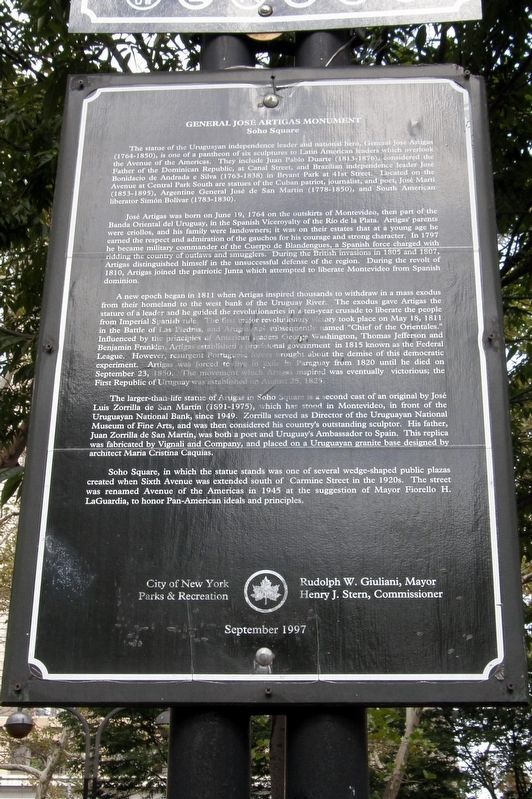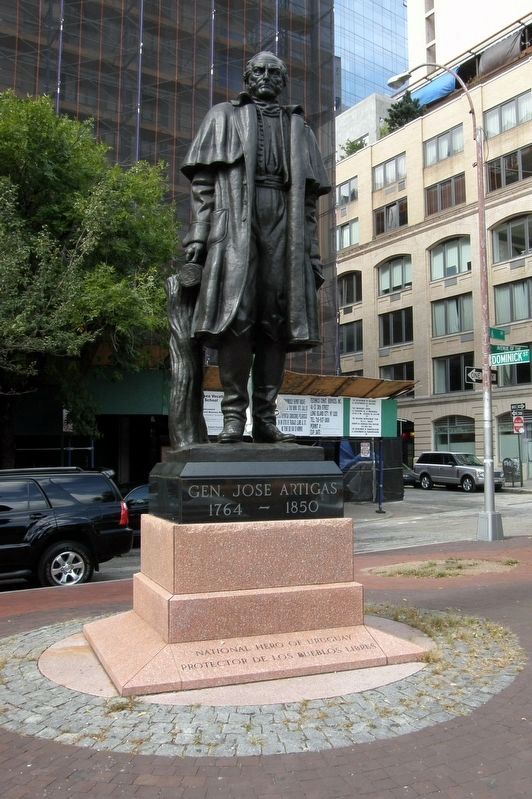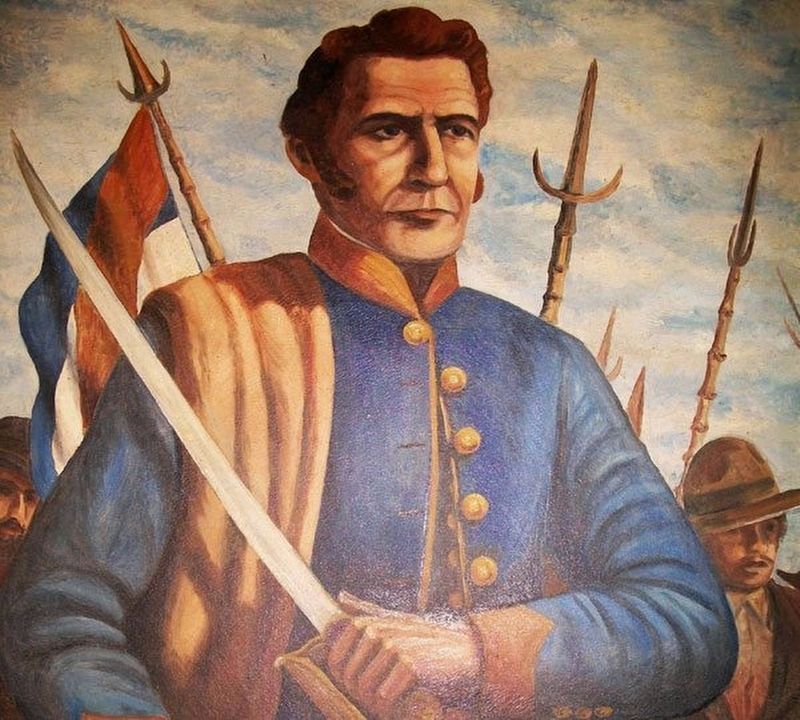Hudson Square in Manhattan in New York County, New York — The American Northeast (Mid-Atlantic)
General José Artigas Monument
Soho Square
The statue of the Uruguayan independence leader and national hero, General José Artigas (1764-1850), is one of a pantheon of six sculptures to Latin American leaders which overlook the Avenue of the Americas. They include Juan Pablo Duarte (1813-1876), considered the Father of the Dominican Republic, at Canal Street, and Brazilian independence leader José Bonidacio de Andrada e Silva (1763-1838) in Bryant Park at 41st Street. Located on the Avenue at Central Park South are statues of the Cuban patriot, journalist, and poet, José Martí (1853-1895), Argentine General José de San Martín (1778-1850), and South American liberator Simón Bolívar (1783-1830).
José Artigas was born on June 19, 1764 on the outskirts of Montevideo, then part of the Banda Oriental del Uruguay, in the Spanish Viceroyalty of the Río de la Plata. Artigas’ parents were criollos, and his family were landowners; it was on their estates that at a young age he earned the respect and admiration of the gauchos for his courage and strong character. In 1797 he became military commander of the Cuerpo de Blandengues, a Spanish force charged with ridding the country of outlaws and smugglers. During the British invasions in 1805 and 1807, Artigas distinguished himself in the unsuccessful defense of the region. During the revolt of 1810, Artigas joined the patriotic Junta which attempted to liberate Montevideo from Spanish dominion.
A new epoch began in 1811 when Artigas inspired thousands to withdraw in a mass exodus from their homeland to the west bank of the Uruguay River. The exodus gave Artigas the stature of a leader and he guided the revolutionaries in a ten-year crusade to liberate the people from Imperial Spanish rule. The first major revolutionary victory took place on May 18, 1811 in the Battle of Las Piedras, and Artigas was subsequently named “Chief of the Orientales.” Influenced by the principles of American leaders George Washington, Thomas Jefferson and Benjamin Franklin, Artigas established a provisional government in 1815 known as the Federal League. However, resurgent Portuguese forces brought about the demise of this democratic experiment. Artigas was forced to live in exile in Paraguay from 1820 until he died on September 23, 1850. The movement which Artigas inspired was eventually victorious; the First Republic of Uruguay was established on August 25, 1825.
The larger-than-life statue of Artigas in Soho Square is a second cast of an original by José Luis Zorrilla de San Martín (1891-1975), which has stood in Montevideo, in front of the Uruguayan National Bank, since 1949. Zorrilla served as Director of the Uruguayan National Museum of Fine Arts, and was then considered his country’s outstanding sculptor.
His father, Juan Zorrilla de San Martín, was both a poet and Uruguay’s Ambassador to Spain. This replica was fabricated by Vignali and Company, and placed on a Uruguayan granite base designed by architect Maria Cristina Caquías.
Soho Square, in which the statue stands was one of several wedge-shaped public plazas created when Sixth Avenue was extended south of Carmine Street in the 1920s. The street was renamed Avenue of the Americas in 1945 at the suggestion of Mayor Fiorello H. LaGuardia, to honor Pan-American ideals and principles.
City of New York Parks & Recreation
Rudolph W. Giuliani, Mayor
Henry J. Stern, Commissioner
September 1997
Erected 1997 by City of New York Parks & Recreation.
Topics. This historical marker and monument is listed in these topic lists: Hispanic Americans • Patriots & Patriotism • Wars, Non-US. A significant historical date for this entry is May 18, 1811.
Location. Marker has been reported missing. It was located near 40° 43.504′ N, 74° 0.27′ W. Marker was in Manhattan, New York, in New York County. It was in Hudson Square. Marker was at the intersection of 6th Avenue and Dominick Street, in the median on 6th Avenue. Located in Spring Street Park aka Soho Square. Touch for map. Marker was in this post office area: New York NY 10013, United States of America. Touch for directions.
Other nearby markers. At least 8 other markers are within walking distance of this location. General José Artigas (a few steps from this marker); Spring Street Park (within shouting distance of this marker); 83,85 Sullivan Street (within shouting distance of this marker); Charlton-King-Vandam Historic District (about 500 feet away, measured in a direct line); 116 Sullivan Street (about 600 feet away); The Holland Tunnel (about 700 feet away); a different marker also named Holland Tunnel (about 700 feet away); Father Fagan Park (about 700 feet away). Touch for a list and map of all markers in Manhattan.
Also see . . .
1. General José Artigas. Official NYCP&R site (Submitted on January 13, 2020, by Larry Gertner of New York, New York.)
2. José Gervasio Artigas. Wikipedia biography (Submitted on January 13, 2020, by Larry Gertner of New York, New York.)
3. The General Jose Artigas Statue - Spring Street Park. Daytonian in Manhattan entry (Submitted on May 8, 2021, by Larry Gertner of New York, New York.)
Credits. This page was last revised on May 14, 2023. It was originally submitted on January 13, 2020, by Larry Gertner of New York, New York. This page has been viewed 320 times since then and 24 times this year. Last updated on May 11, 2023, by Laura Edwards of Bethesda, Maryland. Photos: 1, 2, 3. submitted on January 13, 2020, by Larry Gertner of New York, New York. • J. Makali Bruton was the editor who published this page.


